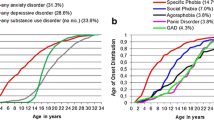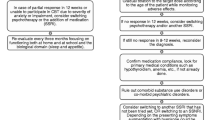Opinion statement
The last decade has seen considerable advances in the treatment of anxiety disorders in children and adolescents and a considerable expansion of the evidence base for psychopharmacologic interventions in this population. The extant data suggest that, for fear-based anxiety disorders (e.g., generalized anxiety disorder, social phobia/social anxiety disorder, and separation anxiety disorder), selective serotonin reuptake inhibitors (SSRIs), and selective serotonin norepinephrine reuptake inhibitors (SSNRIs) are well tolerated and offer considerable benefit. However, the salutary effects of SSRIs and SSNRIs in pediatric anxiety disorders are consistently amplified by the addition of psychotherapy, particularly in individuals with social anxiety disorder. Additionally, several key demographic and clinical factors, including male sex, non-minority status, and better family functioning and younger age predict greater symptomatic improvement in youth with fear-based anxiety disorders. Thus, current data suggest that in addition to several forms of psychotherapy, including cognitive-behavioral therapy (CBT), SSRIs, and SSNRIs are efficacious in the treatment of these conditions in youth and that CBT + an SSRI may be associated with greater improvement than would be expected with either treatment as monotherapy. Finally, given that some children and adolescents may exhibit partial response to current pharmacotherapies, benzodiazepines, anti-histamines, and other agents may have adjunctive roles, despite a lack of data in terms of large, randomized controlled trials.

Similar content being viewed by others
Abbreviations
- SSRI:
-
Selective serotonin reuptake inhibitor
- SAD:
-
Anxiety disorders, separation anxiety disorder
- SoP:
-
Social phobia
- GAD:
-
Generalized anxiety disorder
References and Recommended Reading
Papers of particular interest, published recently, have been highlighted as: • Of importance •• Of major importance
Strauss CC, Frame CL, Forehand R. Psychosocial impairment associated with anxiety in children. J Clin Child Psychol. 1987;16:235–9.
Merikangas KR, He J-P, Burstein M, Swanson SA, Avenevoli S, Cui L, et al. Lifetime prevalence of mental disorders in U.S. adolescents: results from the National Comorbidity Survey Replication—Adolescent Supplement (NCS-A). J Am Acad Child Adolesc Psychiatry. 2010;49(10):980–9.
Kessler RC, Avenevoli S, Costello EJ, Georgiades K, Green JG, Gruber MJ, et al. Prevalence, persistence, and sociodemographic correlates of DSM-IV disorders in the national comorbidity survey replication adolescent supplement. Arch Gen Psychiatry. 2012;69(4):372–80.
Nock MK, Green JG, Hwang I, McLaughlin KA, Sampson NA, Zaslavsky AM, et al. Prevalence, correlates, and treatment of lifetime suicidal behavior among adolescents: results from the National Comorbidity Survey Replication Adolescent Supplement. JAMA Psychiatry. 2013;70(3):300–10.
Pine DS, Cohen P, Gurley D, Brook J, Ma Y. The risk for early-adulthood anxiety and depressive disorders in adolescents with anxiety and depressive disorders. Arch Gen Psychiatry. 1998;55(1):56–64.
Brady EU, Kendall PC. Comorbidity of anxiety and depression in children and adolescents. Psychol Bull. 1992;111(2):244-55
Ialongo N, Edelsohn G, Werthamer-Larsson L, Crockett L, Kellam S. The significance of self-reported anxious symptoms in first grade children: prediction to anxious symptoms and adaptive functioning in fifth grade. J Child Psychol Psychiatry. 1995;36(3):427–37.
Woodward LJ, Fergusson DM. Life course outcomes of young people with anxiety disorders in adolescence. J Am Acad Child Adolesc Psychiatry. 2001;40(9):1086–93.
Langley AK, Bergman RL, McCracken J, Piacentini JC. Impairment in childhood anxiety disorders: preliminary examination of the child anxiety impact scale-parent version. J Child Adolesc Psychopharmacol. 2004;14(1):105–14.
Bastiaansen D, Koot HM, Ferdinand RF, Verhulst FC. Quality of life in children with psychiatric disorders: self-, parent, and clinician report. J Am Acad Child Adolesc Psychiatry. 2004;43(2):221–30.
Rapaport MH, Clary C, Fayyad R, Endicott J. Quality-of-life impairment in depressive and anxiety disorders. Am J Psychiatry. 2005;162:1171–8.
Walkup JT, Albano AM, Piacentini J, Birmaher B, Compton SN, Sherrill JT, et al. Cognitive behavioral therapy, sertraline, or a combination in childhood anxiety. N Engl J Med. 2008;359:2753–66.
Birmaher B, Axelson DA, Monk K, Kalas C, Clark DB, Ehmann M, et al. Fluoxetine for the treatment of childhood anxiety disorders. J Am Acad Child Adolesc Psychiatry. 2003;42(4):415–23.
Strawn JR, Prakash A, Zhang Q, Pangallo BA, Stroud CE, Cai N, et al. A randomized, placebo-controlled study of duloxetine for the treatment of children and adolescents with generalized anxiety disorder. J Am Acad Child Adolesc Psychiatry. 2015;54(4):283–93. This study represents a recent double-blind placebo-controlled study of youth with GAD and summarizes the data that was considered as part of the recent FDA approval of duloxetine for pediatric patients with GAD.
Posner K, Brown GK, Stanley B, Brent DA, Yershova KV, Oquendo MA, et al. The Columbia-Suicide Severity Rating Scale: initial validity and internal consistency findings from three multisite studies with adolescents and adults. Am J Psychiatry. 2011;168(12):1266–77.
March JS, Entusah AR, Rynn M, Albano AM, Tourian KA. A randomized controlled trial of venlafaxine ER versus placebo in pediatric social anxiety disorder. Biol Psychiatry. 2007;62:1149–54.
Wagner KD, Berard R, Stein MB, Wetherhold E, Carpenter DJ, Perera P, et al. A multicenter, randomized, double-blind, placebo-controlled trial of paroxetine in children and adolescents with social anxiety disorder. Arch Gen Psychiatry. 2004;61:1153–62.
Huang X, Li C, Li W, Luo Y, Wang B, Zhang W, et al. Clinical evaluation of the efficacy and safety of tandospirone versus sertraline monotherapy for social anxiety disorder: a randomized open‐label trial. Hum Psychopharmacol Clin Exp. 2013;28(6):594–9.
Compton SN, Walkup JT, Albano AM, Piacentini JC, Birmaher B, Sherrill JT, et al. Child/Adolescent Anxiety Multimodal Study (CAMS): rationale, design, and methods. Child Adolesc Psychiatr Ment Health. 2010;4:1.
Pine DS, Walkup JT, Labellarte MJ, Riddle MA, Greenhill L, Klein R, et al. Fluvoxamine for the treatment of anxiety disorders in children and adolescents. N Engl J Med. 2001;344:1279–85.
Ginsburg GS, Riddle MA, Davies M. Somatic symptoms in children and adolescents with anxiety disorders. J Am Acad Child Adolesc Psychiatry. 2006;45(10):1179–87.
Fairbanks JM, Pine DS, Tancer NK, Dummit III ES, Kentgen LM, Martin J, et al. Open fluoxetine treatment of mixed anxiety disorders in children and adolescents. J Child Adolesc Psychopharmacol. 1997;7:17–29.
Simeon JG, Ferguson HB, Knott V, Roberts N, Gauthier B, Dubois C, et al. Clinical, cognitive, and neurophysiological effects of alprazolam in children and adolescents with overanxious and avoidant disorders. J Am Acad Child Adolesc Psychiatry. 1992;31(1):29–33.
Graae F, Milner J, Rizzotto L, Klein RG. Clonazepam in childhood anxiety disorders. J Am Acad Child Adolesc Psychiatry. 1994;33(3):372–6.
Strawn J, Compton S, Robertson B, Albano A, Hamdani M, Rynn M. Guanfacine extended-release in pediatric anxiety disorders: a randomized, placebo-controlled trial. Annual Meeting of the Anxiety and Depression Association of America, Philadelphia, PA. 2016.
Masi G, Toni C, Mucci M, Millepiedi S, Mata B, Perugi G. Paroxetine in child and adolescent outpatients with panic disorder. J Child Adolesc Psychopharmacol. 2001;11(2):151–7.
Marks DM, Park M-H, Ham B-J, Han C, Patkar AA, Masand PS, et al. Paroxetine: safety and tolerability issues. London: Informa UK Ltd; 2008.
Connolly SD, Bernstein GA. Practice parameter for the assessment and treatment of children and adolescents with anxiety disorders. J Am Acad Child Adolesc Psychiatry. 2007;46(2):267–83.
Wehry AM, Beesdo-Baum K, Hennelly MM, Connolly SD, Strawn JR. Assessment and treatment of anxiety disorders in children and adolescents. Curr Psychiatry Rep. 2015;17(7):52.
Ginsburg GS, Kendall PC, Sakolsky D, Compton SN, Piacentini J, Albano AM, et al. Remission after acute treatment in children and adolescents with anxiety disorders: findings from the CAMS. J Consult Clin Psychol. 2011;79:806–13.
Gonzalez A, Peris TS, Vreeland A, Kiff CJ, Kendall PC, Compton SN, et al. Parental anxiety as a predictor of medication and CBT response for anxious youth. Child Psychiatry Hum Dev. 2014.
Compton SN, Peris TS, Almirall D, Birmaher B, Sherrill J, Kendall PC, et al. Predictors and moderators of treatment response in childhood anxiety disorders: results from the CAMS trial. J Consult Clin Psychol. 2014;71(3):310–8. This is a thorough review of clinical and demographic factors which influence treatment reponse in pediatric patients with anxiety disorders.
Masi G, Pfanner C, Mucci M, Berloffa S, Magazù A, Parolin G, et al. Pediatric social anxiety disorder: predictors of response to pharmacological treatment. J Child Adolesc Psychopharmacol. 2012;22(6):410–4.
Strawn JR, Welge JA, Wehry AM, Keeshin B, Rynn MA. Efficacy and tolerability of antidepressants in pediatric anxiety disorders: a systematic review and meta-analysis. Depress Anxiety. 2015;32(3):149–57. This is currently the only meta-analysis of antidepressants in youth with non-OCD anxiety disorders and suggests a moderate effect size and a favorable tolerability profile
Mohatt J, Bennett SM, Walkup JT. Treatment of separation, generalized, and social anxiety disorders in youths. Am J Psychiatry. 2014;171(7):741–8.
Author information
Authors and Affiliations
Corresponding author
Ethics declarations
Conflict of Interest
Eric T. Dobson declares that he has no conflict of interest.
Farah S. Hussain declares that she has no conflict of interest.
Jeffrey R. Strawn reports grants and other from National Institute of Mental Health, grants from Shire, grants from Eli Lilly, grants from Forest Research Institute, grants from Lundbeck, grants from Edgemont, other from Neuronetics, royalties from Springer Publishing, material support from Assurex, outside the submitted work.
Human and Animal Rights and Informed Consent
This article contains references to published studies with human subjects performed—in part—by Jeffrey R. Strawn, MD. These clinical trials were conducted in accordance with ethical guidelines and all studies on which Dr. Strawn was an author or investigator were reviewed an approved by appropriate institutional review boards.
Additional information
This article is part of the Topical Collection on Child and Adolescent Psychiatry
Rights and permissions
About this article
Cite this article
Hussain, F.S., Dobson, E.T. & Strawn, J.R. Pharmacologic Treatment of Pediatric Anxiety Disorders. Curr Treat Options Psych 3, 151–160 (2016). https://doi.org/10.1007/s40501-016-0076-7
Published:
Issue Date:
DOI: https://doi.org/10.1007/s40501-016-0076-7




